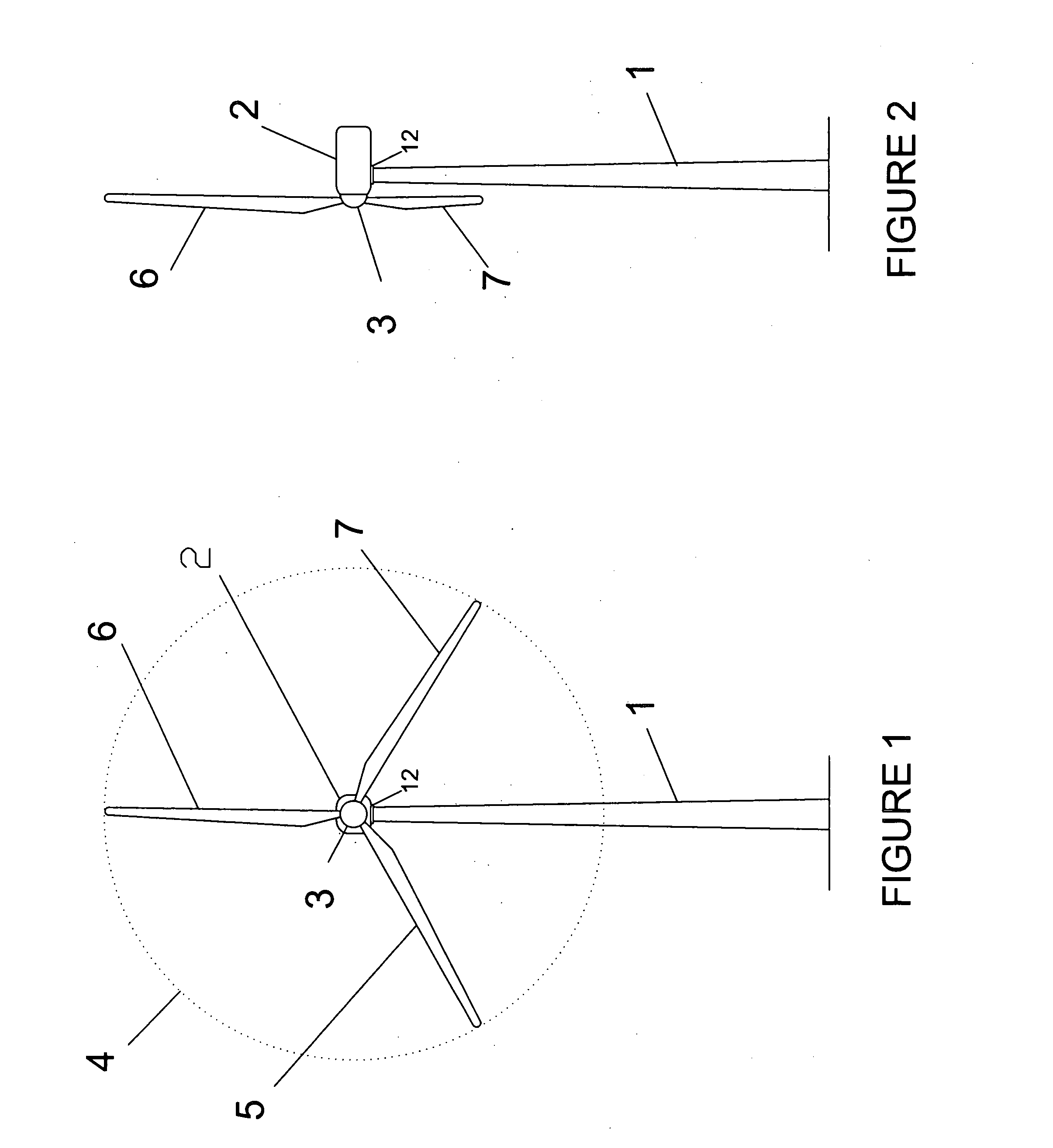Wind turbine
a technology of wind turbines and turbines, which is applied in the direction of machines/engines, sustainable buildings, and electric generator control, etc., can solve the problems of unnecessarily increasing the downtime of the turbine, the turbine is effectively “top heavy”, and the top heavy structure has a tendency to vibrate and oscillate, etc. problems, to achieve the effect of building more economically, reducing the number of turbine downtime, and reducing the difficulty of maintenance of the operating components
- Summary
- Abstract
- Description
- Claims
- Application Information
AI Technical Summary
Benefits of technology
Problems solved by technology
Method used
Image
Examples
first embodiment
[0055]FIG. 4 shows the subject invention. The rotor (of which two of the 3 blades are shown) is connected via a horizontal shaft 8 to gear box 14. Gear box 14 converts horizontal axis rotation from the rotors to a vertical axis rotation for a downward extending shaft 15. Shaft 15 extends downward to thrust bearing 27. 12 is the yaw mechanism. In this embodiment, the yawing mechanism is shown at the top of the tower similar to conventional turbines. The tower cross-section is conventionally round in shape and only the nacelle turns during yaw adjustments. Thrust bearing 27 is supported by a mezzanine support system depicted by platform 28 and support members 34. Lower connecting shaft 29 links shaft 15 through thrust bearing 27 to direct drive generator 17. Lower tower housing 16a enlarges near the base of the tower to enclose the operating components located inside. Direct-drive generators are one method of converting rotational shaft torque into electricity. Upper tower portion 16b...
second embodiment
[0057]FIG. 5 shows the subject invention. The rotor (of which two of the 3 blades are shown) is connected via a horizontal shaft 8 to gear box 14. Gear box 14 converts horizontal axis rotation from the rotors to a vertical axis rotation for a downward extending shaft 15. Shaft 15 extends downward through yaw mechanism 12 to thrust bearing 27. Thrust bearing 27 is supported by a mezzanine support system depicted by platform 28 and support members 30. Lower connecting shaft 29 links shaft 15 through thrust bearing 27 to transmission 18. The transmission is designed to increase rotational mechanical advantage from vertical shaft 15. It is envisioned that in one embodiment of the subject invention transmission 18 would increase rotation by a ratio of 1:30. Transmission 18 is connected to generator 19 for the production of electrical power. Combination transmission-generator sets can be more cost effective to manufacture and require less room than direct-drive generators. Tower housing 1...
third embodiment
[0058]FIG. 6 shows the subject invention. The rotor (of which two of the 3 blades are shown) is connected via a horizontal shaft 8 to gear box 14. Gear box 14 converts horizontal axis rotation from the rotors to a vertical axis rotation for a downward extending shaft 20. Shaft 20 extends downward through yaw mechanism 12 to thrust bearing 27. Thrust bearing 27 is supported by a mezzanine support system depicted by platform 28 and support members 30. Lower connecting shaft 29 links shaft 20 through thrust bearing 27 to transmission 18. Transmission 18 is connected to generator 19 for the production of electrical power. In order to prevent warping or misalignment of shaft 20 sleeve 22 surrounds the shaft. Sleeve 22 is supported independently from shaft 20 by a second mezzanine support structure depicted by platform 32 and support members 31. Shaft 20 is constructed from at least two lengths and joined at joint 21. Taller towers will likely employ multiple shaft lengths 20 joined at re...
PUM
 Login to View More
Login to View More Abstract
Description
Claims
Application Information
 Login to View More
Login to View More - R&D
- Intellectual Property
- Life Sciences
- Materials
- Tech Scout
- Unparalleled Data Quality
- Higher Quality Content
- 60% Fewer Hallucinations
Browse by: Latest US Patents, China's latest patents, Technical Efficacy Thesaurus, Application Domain, Technology Topic, Popular Technical Reports.
© 2025 PatSnap. All rights reserved.Legal|Privacy policy|Modern Slavery Act Transparency Statement|Sitemap|About US| Contact US: help@patsnap.com



